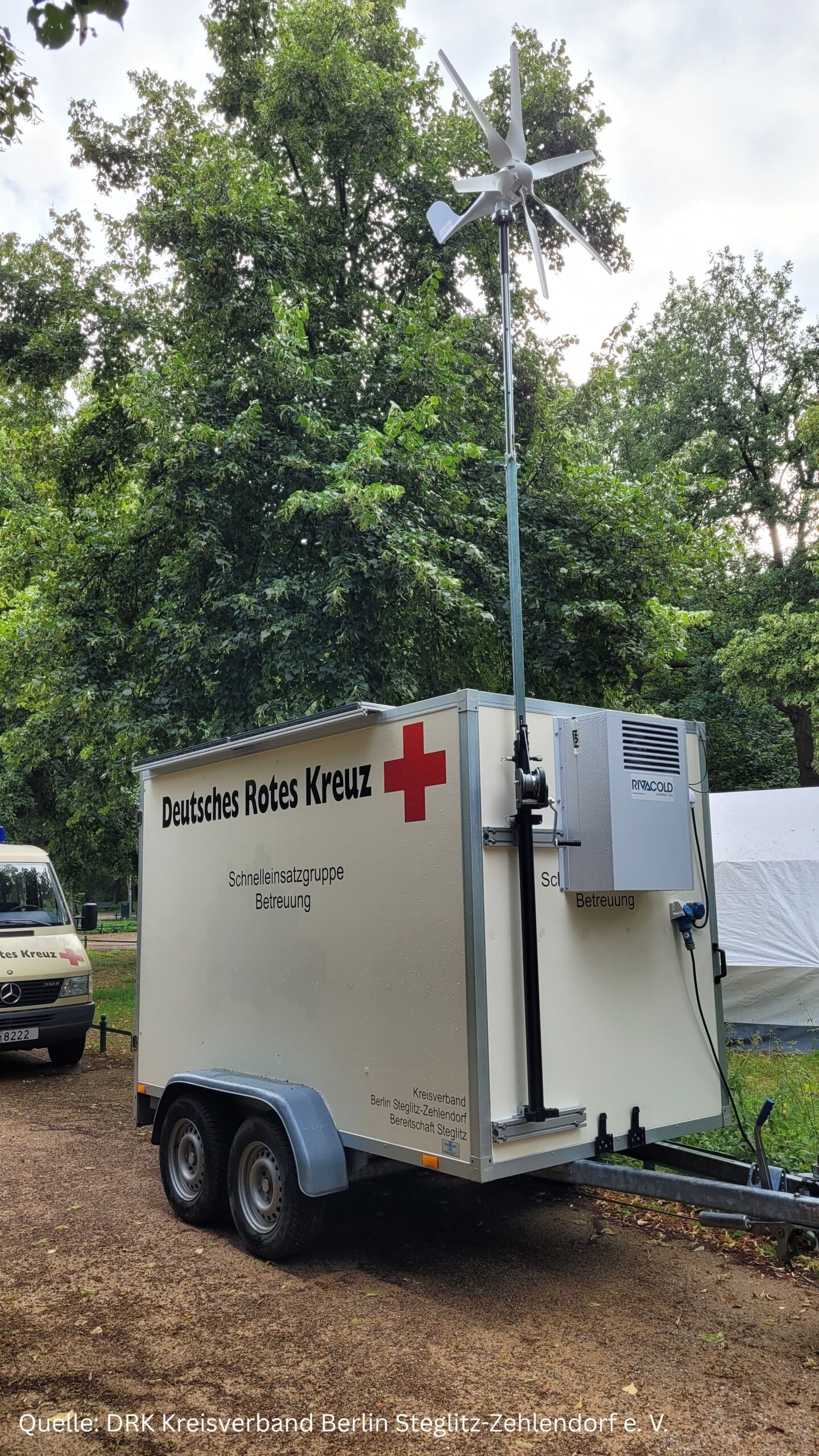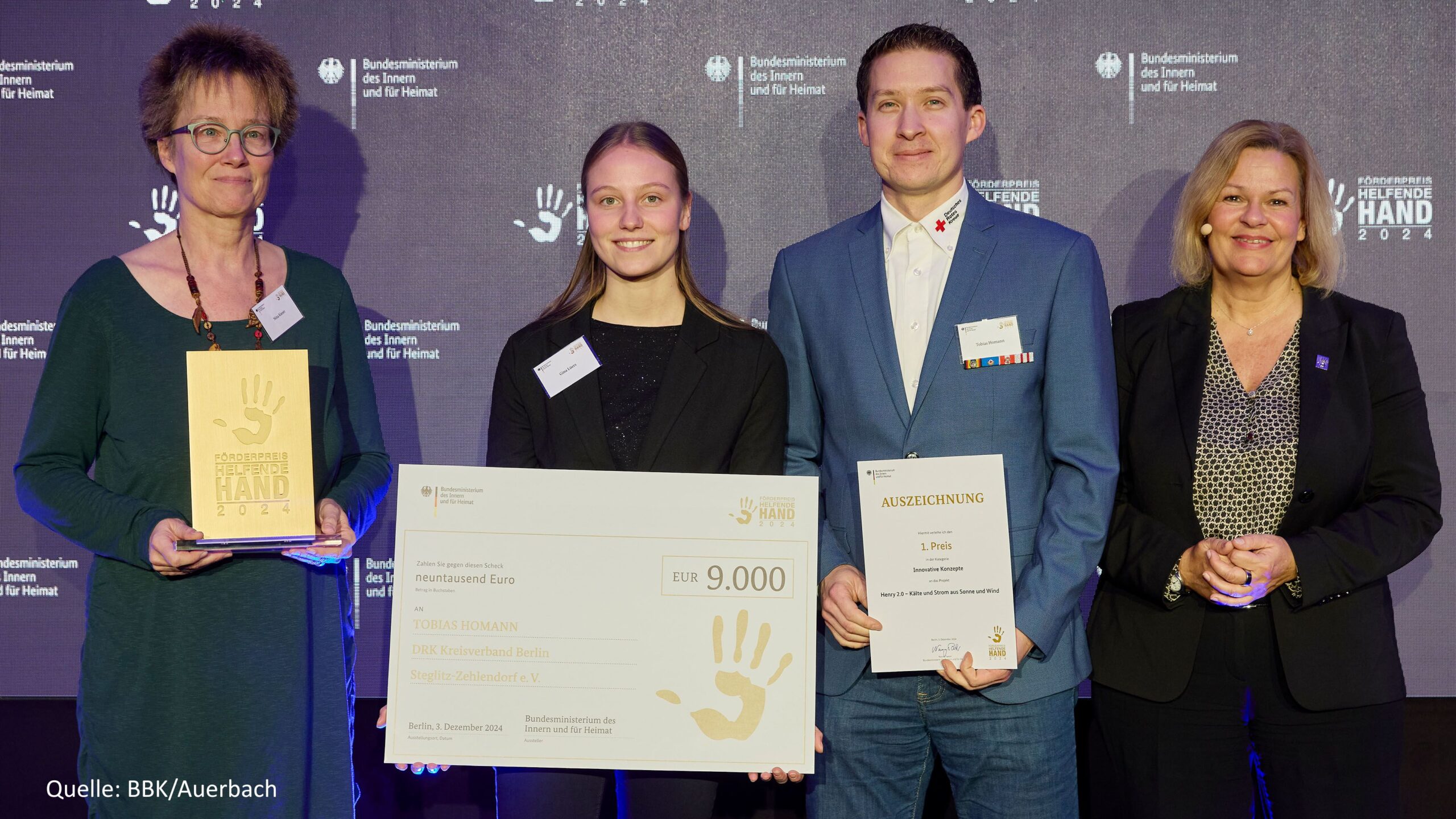12.05.2025 | Interviews
The ‘Henry 2.0’ project combines innovative technology with sustainable energy production to provide mobile cooling facilities for disaster management. A reliable and environmentally friendly energy supply is essential, especially in crisis situations. In times of climate change, this aspect is becoming increasingly important. The project was honoured with the ‘Helping Hand’ award for its pioneering idea. Tobias Homann, a long-standing member of the German Red Cross and co-initiator of ‘Henry 2.0’, talks about the origins, challenges and future plans of this special project.
 Far-sighted volunteer work
Far-sighted volunteer work
Tobias Homann has been a volunteer with the German Red Cross (DRK) for more than 26 years. As a paramedic, organisation leader and in management positions, he has experienced and helped shape numerous operations. In the ‘Henry 2.0’ project, he is part of the team led by project manager Gina Lüers. Together with other members of the Berlin Steglitz-Zehlendorf DRK district association, he created and implemented the sustainable catering system.
From idea to realisation
‘In 2022, a grant from the Berlin S-Bahn gave us the opportunity to convert an old trailer for food distribution – the “Henry” project idea was born,’ recalls Tobias Homann. But it was only during a major operation in Berlin’s Grunewald forest that the need for another trailer to secure the cold chain became apparent.
“The idea of converting another trailer for cooling food and drinks was born during the fire in Berlin’s Grunewald forest. The Berlin Steglitz-Zehlendorf district association was tasked with catering for the approx. 330 emergency services from the fire brigade, police, Berlin Forestry, etc. But with temperatures well over 30°C, maintaining the cold chain was a major challenge for the volunteers,” says Tobias Homann. This gave rise to the idea of ‘Henry 2.0’ – a climate-friendly refrigerated trailer that generates most of its own energy. Thanks to an internal DRK grant, this project could be financed and realised.
Sustainable solution for disaster management
‘Henry 2.0’ is an innovative and environmentally friendly addition to existing systems. The trailer can operate autonomously and is largely independent of an external power supply. ““Henry 2.0” has two solar cells and a wind turbine. This makes the trailer different and significantly less dependent on the infrastructure that would otherwise be required,” explains Tobias Homann. This system offers decisive advantages, particularly in crisis situations where a stable infrastructure cannot be guaranteed.
The combination of field kitchen, distribution trailer and ‘Henry 2.0’ forms a coordinated catering system that enables several hundred people to be fed efficiently. ‘Of course, we still need gas for cooking in the field kitchen, but the lighting, cooling and communication can be provided by the solar cells and the wind turbine if the conditions are right,’ says Tobias Homann. ‘There is therefore no longer any need for regular refuelling of power generators, for example.’
Challenges and solutions
A key issue in the realisation of the project was the storage of the energy generated. “As with many systems, storing the electricity generated is one of the biggest challenges. When the sun isn’t shining and the wind isn’t blowing, we still need electricity for cooling,” explains Tobias Homann.
Should a bottleneck nevertheless occur, ‘Henry 2.0’ can be supplied with external electricity, ideally from renewable sources: “In this case, the trailer has two batteries, which hopefully still have energy stored from the previous day. In an emergency, however, “Henry 2.0” also has a way of feeding in – hopefully green – electricity externally.”
Significance in the context of climate change
Climate change is leading to ever more frequent extreme weather events, which are increasingly challenging the field of civil protection. Sustainable solutions such as ‘Henry 2.0’ not only help to provide effective aid, but also to reduce our own emissions. “We can all see that climate change is progressing. Floods like those in the Ahr valley or in Spain, fires like those in the USA, southern Europe and Saxony show us that it is high time to act, even on our own doorstep,” emphasises Tobias Homann. ‘In my view, it is only logical that those who rush to help in such cases also do their bit to prevent the cause from being exacerbated.’
Tobias Homann sees great future potential in this approach: ‘If you understand “Henry 2.0” as the idea of making components and technical resources more climate-friendly by focussing on renewable power generation, then I can see solar cells on the roofs of all emergency response lorries in the future.’
 Awarded with the ‘Helping Hand’
Awarded with the ‘Helping Hand’
The innovative idea and its sustainable approach were honoured with the ‘Helping Hand’ award from the Federal Ministry of the Interior and Community. For Tobias Homann and his team, this is not only a great honour, but also an opportunity to further develop the project.
“Internally, the “Helping Hand” award is an enormous honour for volunteers. For me personally, appreciation in voluntary work is very important. In my eyes, it is the basis for successful work for the benefit of all,” says Tobias Homann. ‘The prize money gives us the opportunity to further expand the two trailers and realise our other ideas.’
Looking to the future
The project is not yet complete. The use of ‘Henry 2.0’ will continue to be trialled in practice in order to identify weak points and make improvements. The trailer can be used in a variety of ways: whether for large forest fires, power outages or planned major events – the climate-friendly catering system can be used flexibly to supply emergency services and affected citizens. It also helps to establish the German Red Cross as a player for sustainable solutions in disaster management.
Appeal to organisations and volunteers
Tobias Homann is convinced that sustainable solutions will play an even greater role in disaster management in the future. His advice to other organisations: “Where there’s a will, there’s a way. If an idea arises within the structures to make an area of civil protection more sustainable or otherwise better, then a way will also be found to implement this idea.”
‘Henry 2.0’ shows how innovative technology and renewable energies can work together to make disaster management more sustainable. In a world that is increasingly characterised by climate challenges, the project sets an important example for sustainable solutions – and proves that volunteering and environmental awareness can go hand in hand.